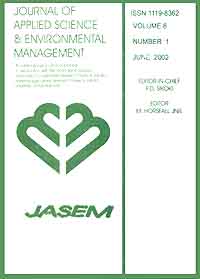
|
Journal of Applied Sciences and Environmental Management
World Bank assisted National Agricultural Research Project (NARP) - University of Port Harcourt
ISSN: 1119-8362
Vol. 22, No. 8, 2018, pp. 1269-1275
|
 Bioline Code: ja18212
Bioline Code: ja18212
Full paper language: English
Document type: Research Article
Document available free of charge
|
|
|
Journal of Applied Sciences and Environmental Management, Vol. 22, No. 8, 2018, pp. 1269-1275
| en |
Land Change Detection and Effective Factors on Forest Land Use Changes: Application of Land Change Modeler and Multiple Linear Regression
JAHANIFAR, K; AMIRNEJAD, H; MOJAVERIAN, M & AZADI, H
Abstract
Reducing forest covered areas and changing it to pasture, agricultural, urban and rural areas is performed
every year and this causes great damages in natural resources in a wide range. In order to identify the effective factors on
reducing the forest cover area, multiple regression was used from 1995 to 2015 in Mazandaran forests. A Multiple
regressions can link the decline in forest cover (dependent variable) and its effective factors (independent variable) are well
explained. In this study, Landsat TM data of 1995 and Landsat ETM+ data of 2015 were analyzed and classified in order to
investigate the changes in the forest area. The images were classified in two classes of forest and non-forest areas and also
forest map with spatial variables of physiography and human were analyzed by regression equation. Detection satellite
images showed that during the studied period there was found a reduction of forest areas up to approximately 257331 ha.
The results of regression analysis indicated that the linear combination of income per capita, rain and temperature with
determined coefficient 0.4 as independent variables were capable of estimating the reduction of forest area. The results of
this study can be used as an efficient tool to manage and improve forests regarding physiographical and human
characteristics.
Keywords
Land change Modeler; Multiple linear regression; remote sensing; Mazandaran forests
|
| |
© Copyright 2018 - Jahanifar et al.
|
|
